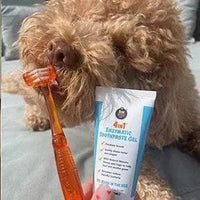Noticing redness in your dog’s eyes can be concerning, especially if it appears suddenly or is accompanied by discomfort. While occasional eye redness may be harmless, it can also signal an underlying health issue that needs attention. Understanding the possible causes, knowing when to seek veterinary care, and learning how to keep your dog’s eyes healthy can help prevent serious complications.

What Causes Red Eyes in Dogs?
A dog’s eyes can become red for several reasons, ranging from mild irritation to more serious medical conditions. Here are some of the most common causes:
- Allergies – Just like humans, dogs can have allergic reactions to pollen, dust, smoke, or certain foods, leading to red, itchy eyes.
- Irritants – Exposure to wind, smoke, chemicals, or even shampoo during baths can cause temporary redness.
- Dry Eye (Keratoconjunctivitis Sicca) – A condition where the eyes don’t produce enough tears, leading to inflammation and irritation.
- Conjunctivitis (Pink Eye) – An infection or inflammation of the conjunctiva that causes redness, swelling, and discharge.
- Glaucoma – Increased pressure in the eye, which can cause redness, pain, and potential vision loss if untreated.
- Corneal Ulcers – Scratches or injuries to the cornea that may cause redness, excessive blinking, and sensitivity to light.
- Cherry Eye – A prolapse of the third eyelid gland, creating a noticeable red or pink mass in the corner of the eye.
Recognizing the cause of your dog’s red eyes is the first step in determining the best course of action.
What Dogs Are Susceptible to Eye Problems?
Certain breeds are more prone to eye issues due to their genetics, facial structure, or predisposition to specific conditions. Some of the most vulnerable breeds include:
- Brachycephalic breeds (Pugs, Bulldogs, Shih Tzus) – Their prominent eyes make them more susceptible to irritation, dry eye, and corneal ulcers.
- Cocker Spaniels and Cavalier King Charles Spaniels – These breeds are prone to dry eye and glaucoma.
- Retrievers (Golden Retrievers, Labrador Retrievers) – More likely to develop eye conditions like cataracts or progressive retinal atrophy (PRA).
- Shar-Peis and Bloodhounds – Prone to eyelid abnormalities, such as entropion, where the eyelid rolls inward, irritating the eye.
If your dog is one of these breeds, regular eye checkups and early intervention are essential.
Other Eye Problems in Dogs
Beyond redness, several other eye issues can affect dogs, including:
- Excessive tearing (Epiphora) – Watery eyes may indicate allergies, blocked tear ducts, or infections.
- Swelling or puffiness – Can be a sign of injury, infection, or an underlying health condition.
- Yellow or green discharge – Often a sign of infection that requires veterinary treatment.
- Cloudy eyes – Could indicate cataracts, glaucoma, or other vision-related conditions.
- Squinting or excessive blinking – May signal pain, injury, or irritation.
Paying attention to additional symptoms can help you determine whether your dog’s red eyes require medical attention.
How to Treat Bloodshot Eyes in Dogs
The right treatment depends on the cause of the redness. Here are some common approaches:
- For minor irritation – Gently rinse your dog’s eyes with a vet-approved saline solution to remove dust or debris.
- For allergies – Your vet may recommend antihistamines or eye drops to reduce inflammation.
- For infections – Bacterial or viral infections may require antibiotic or anti-inflammatory eye drops.
- For dry eye – Medications that stimulate tear production can help manage the condition.
- For corneal ulcers or injuries – Your vet will likely prescribe medicated drops or ointments to promote healing.
Never use human eye drops on your dog without veterinary approval, as some ingredients can be harmful.

When Is It Time to Take My Dog to the Vet?
While mild redness may not always be a cause for alarm, there are certain signs that indicate a more serious issue requiring veterinary attention. Contact your vet if your dog experiences:
- Persistent or worsening redness
- Swelling or bulging of the eye
- Excessive tearing or thick discharge
- Squinting, blinking, or pawing at the eye
- Cloudiness or vision changes
- Lethargy or signs of pain
Early detection and treatment can prevent long-term damage and keep your dog’s vision healthy.
How to Keep Your Dog’s Eyes Healthy
Preventative care is key to maintaining your dog’s eye health. Here are some simple ways to protect their vision:
- Keep their face clean – Gently wipe away dirt, debris, and discharge using a damp cloth or pet-safe wipes.
- Avoid irritants – Keep your dog away from smoke, strong cleaning chemicals, and dusty environments.
- Trim hair around the eyes – Long fur can cause irritation or trap debris, leading to redness and infections.
- Schedule regular vet checkups – Routine eye exams can help detect problems early before they become serious.
- Use protective eyewear – If your dog loves sticking their head out of the car window, consider dog goggles to shield their eyes from wind and debris.
By taking these simple steps, you can help prevent common eye issues and keep your dog’s vision clear and healthy.
Red Eyes in Dogs: When to Worry and How to Help
Red eyes in dogs can be caused by a variety of factors, from minor irritation to more serious health concerns. Understanding the potential causes, recognizing warning signs, and knowing when to seek veterinary care can help ensure your furry friend stays happy and healthy. If you ever have concerns about your dog’s eye health, don’t hesitate to consult your vet for guidance.















